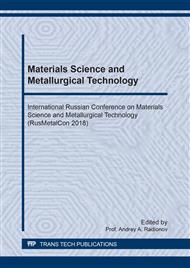p.906
p.913
p.921
p.928
p.934
p.939
p.945
p.950
p.959
Dependence of Cold Cracks Formation from the Heat Input when Welding of High Strength Steel with Yield Strength of 500 MPa
Abstract:
The weldability of high strength steel of grade 10G2FBY with a yield strength of 500 MPa is conducted in this paper according to the criterion of cold cracks formation in the seam root of plates with a thickness of 18 and 36 mm. The study was carried out in accordance with GOST 26388-84 on samples of type IX at ambient temperatures from –20 to +20 °С at heat input energy from 5.8 to 14.3 kJ/cm. After welding, the plates were cooled in the air for 24 hours. The main criterion for assessing weldability is the presence or absence of cold cracks after welding. The welding was made with a soft wire 4Y42 with a yield strength of 420 MPa. Cold cracks in high strength steel 10G2FBU for thicknesses of 18 and 36 mm are not detected in heat input over 10.3 kJ/cm by welding at the temperature of +20 °С, at the same time when welding at an ambient temperature of -20 °С cracks are not detected when running over energy of 14.7 kJ/cm. Critical cooling rate in which no cracks appeared was 55 °С/s at the temperature of welding +20 °С, and it was 44 °С/s at a temperature of welding –20 °С for both thicknesses. The criterion HVmax<300 HV is a necessary but insufficient condition for the prevention of cold cracking in steels of the type 10G2FBU. In the conditions of the experiment, cold cracks in the weld seam are absent at a hardness of no more than 250-260 HV, which is probably due to the presence of diffusive hydrogen, which is not regulated in the regulations for the supply of this steel grade
Info:
Periodical:
Pages:
934-938
Citation:
Online since:
February 2019
Authors:
Keywords:
Price:
Сopyright:
© 2019 Trans Tech Publications Ltd. All Rights Reserved
Share:
Citation:


